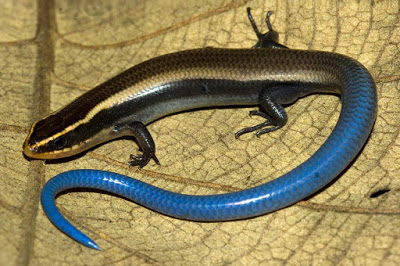The Fossil are found in fissures in the rock and have been interpreted as the inhabitants and prey of the animals that lived in the caves. The presence of bat fossils confirms the hypothesis that these fissures were part of a cave system.
All our material coming from this locality is part of the endemic microfauna, with most of the pieces measuring a few mm in length. Magnification is needed to properly visualize these fossils, but they are wonderful examples of an ancient cave environment of 28 million years.
Plestiodon (Reptilia, Squamata, Sauria, Scincomorpha, Scincidae, Scincinae) is a genus of saurian of the skink family. With over 1,500 living species described, Scincidae is one of the most diverse lizards families.
The word "skink" comes from the classical Greek skinkos, a name that referred to various specific lizards of the region.
The skinks look like real lizards, but most species do not have a pronounced neck and their legs are relatively small; different genres (eg Typhlosaurus) do not have limbs at all. Other genera, like Neoseps, have reduced limbs and with less than five fingers on each foot. In such species, their locomotion resembles that of snakes more than that of lizards with well-developed limbs. As a general rule, the longer the phalanges are long, the more likely it is that the species is arboreal.

Most species of skinks have long and tapered tails that can detach if predators grab them. Such species can generally regenerate the lost part of a tail, though imperfectly. The species with the squat tail do not have special regenerative abilities.
Some species of skinks are rather small, about 7 cm, more than half represented by the tail. Most of the skinks, however, are of medium size, with lengths of 12 cm; the skink of the Solomon Islands is the largest species still existing and can reach a length of about 35 cm.
The skink-like lizards appear for the first time in the fossil record about 140 million years ago, during the first Cretaceous, mostly jaw bones. The fossils of complete skeletons have been dated to the Miocene period.
Most skinks spend their time underground, where they are mostly safe from predators. When they meet their prey, they chase it until they knock it down or land it with a bite and then swallow it completely. They are generally carnivores and in particular insectivores.



